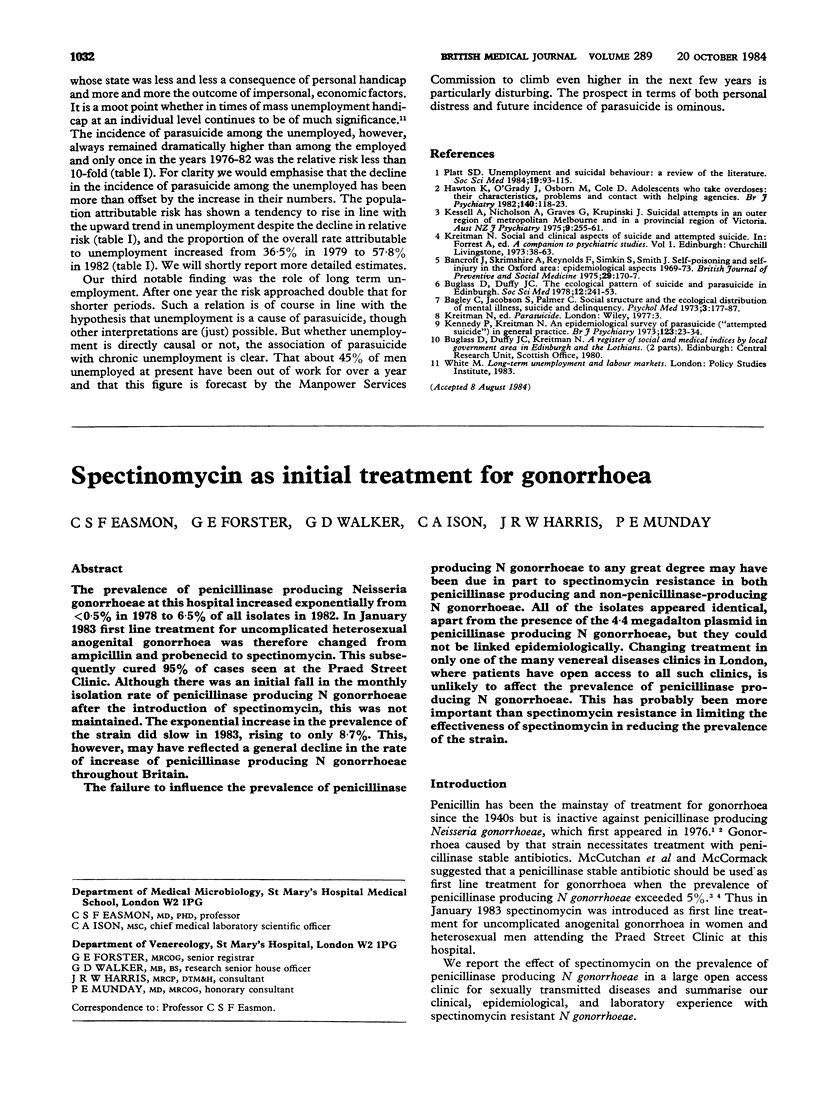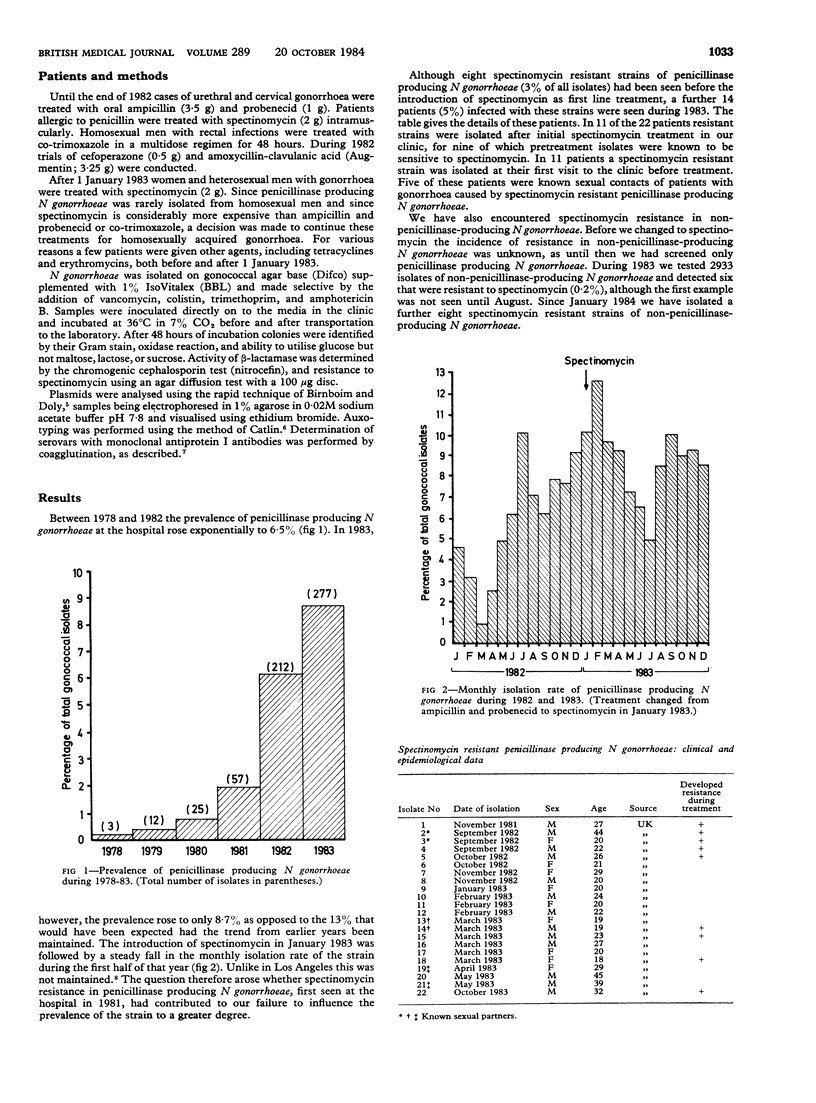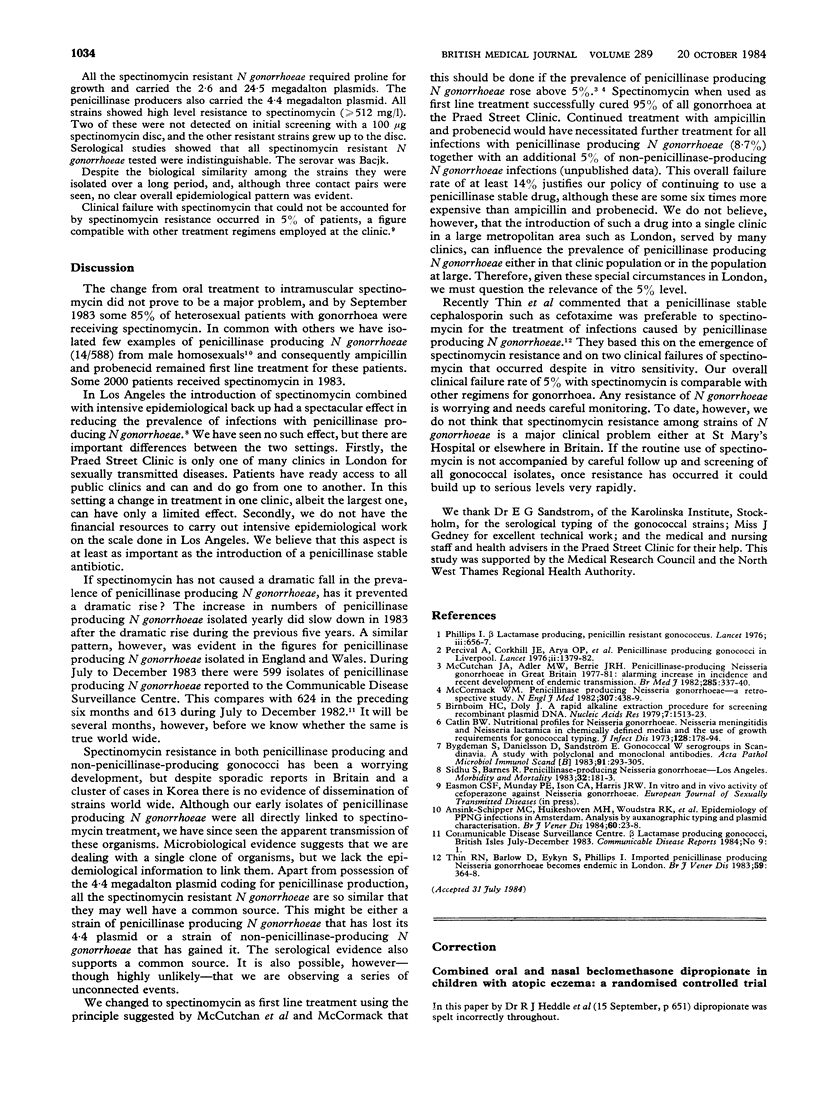Abstract
The prevalence of penicillinase producing Neisseria gonorrhoeae at this hospital increased exponentially from less than 0.5% in 1978 to 6.5% of all isolates in 1982. In January 1983 first line treatment for uncomplicated heterosexual anogenital gonorrhoea was therefore changed from ampicillin and probenecid to spectinomycin. This subsequently cured 95% of cases seen at the Praed Street Clinic. Although there was an initial fall in the monthly isolation rate of penicillinase producing N gonorrhoeae after the introduction of spectinomycin, this was not maintained. The exponential increase in the prevalence of the strain did slow in 1983, rising to only 8.7%. This, however, may have reflected a general decline in the rate of increase of penicillinase producing N gonorrhoeae throughout Britain. The failure to influence the prevalence of penicillinase producing N gonorrhoeae to any great degree may have been due in part to spectinomycin resistance in both penicillinase producing and non-penicillinase-producing N gonorrhoeae. All of the isolates appeared identical, apart from the presence of the 4.4 megadalton plasmid in penicillinase producing N gonorrhoeae, but they could not be linked epidemiologically. Changing treatment in only one of the many venereal diseases clinics in London, where patients have open access to all such clinics, is unlikely to affect the prevalence of penicillinase producing N gonorrhoeae. This has probably been more important than spectinomycin resistance in limiting the effectiveness of spectinomycin in reducing the prevalence of the strain.
Full text
PDF


Selected References
These references are in PubMed. This may not be the complete list of references from this article.
- Ansink-Schipper M. C., Huikeshoven M. H., Woudstra R. K., van Klingeren B., de Koning G. A., Tio D., Schoonhoven F. J., Coutinho R. A. Epidemiology of PPNG infections in Amsterdam: analysis by auxanographic typing and plasmid characterisation. Br J Vener Dis. 1984 Feb;60(1):23–28. doi: 10.1136/sti.60.1.23. [DOI] [PMC free article] [PubMed] [Google Scholar]
- Birnboim H. C., Doly J. A rapid alkaline extraction procedure for screening recombinant plasmid DNA. Nucleic Acids Res. 1979 Nov 24;7(6):1513–1523. doi: 10.1093/nar/7.6.1513. [DOI] [PMC free article] [PubMed] [Google Scholar]
- Bygdeman S., Danielsson D., Sandström E. Gonococcal W serogroups in Scandinavia. A study with polyclonal and monoclonal antibodies. Acta Pathol Microbiol Immunol Scand B. 1983 Oct;91(5):293–305. [PubMed] [Google Scholar]
- Catlin B. W. Nutritional profiles of Neisseria gonorrhoeae, Neisseria meningitidis, and Neisseria lactamica in chemically defined media and the use of growth requirements for gonococcal typing. J Infect Dis. 1973 Aug;128(2):178–194. doi: 10.1093/infdis/128.2.178. [DOI] [PubMed] [Google Scholar]
- McCormack W. M. Penicillinase-producing Neisseria gonorrhoeae--a retrospective. N Engl J Med. 1982 Aug 12;307(7):438–439. doi: 10.1056/NEJM198208123070712. [DOI] [PubMed] [Google Scholar]
- McCutchan J. A., Adler M. W., Berrie J. R. Penicillinase-producing Neisseria gonorrhoeae in Great Britain, 1977-81: alarming increase in incidence and recent development of endemic transmission. Br Med J (Clin Res Ed) 1982 Jul 31;285(6338):337–340. doi: 10.1136/bmj.285.6338.337. [DOI] [PMC free article] [PubMed] [Google Scholar]
- Percival A., Rowlands J., Corkill J. E., Alergant C. D., Arya O. P., Rees E., Annels E. H. Penicillinase-producing Gonococci in Liverpool. Lancet. 1976 Dec 25;2(8000):1379–1382. doi: 10.1016/s0140-6736(76)91919-x. [DOI] [PubMed] [Google Scholar]
- Thin R. N., Barlow D., Eykyn S., Phillips I. Imported penicillinase producing Neisseria gonorrhoeae becomes endemic in London. Br J Vener Dis. 1983 Dec;59(6):364–368. doi: 10.1136/sti.59.6.364. [DOI] [PMC free article] [PubMed] [Google Scholar]


